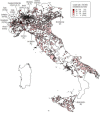The epidemiology of malignant mesothelioma in women: gender differences and modalities of asbestos exposure
- PMID: 29269563
- PMCID: PMC5878657
- DOI: 10.1136/oemed-2016-104119
The epidemiology of malignant mesothelioma in women: gender differences and modalities of asbestos exposure
Abstract
Introduction: The epidemiology of gender differences for mesothelioma incidence has been rarely discussed in national case lists. In Italy an epidemiological surveillance system (ReNaM) is working by the means of a national register.
Methods: Incident malignant mesothelioma (MM) cases in the period 1993 to 2012 were retrieved from ReNaM. Gender ratio by age class, period of diagnosis, diagnostic certainty, morphology and modalities of asbestos exposure has been analysed using exact tests for proportion. Economic activity sectors, jobs and territorial distribution of mesothelioma cases in women have been described and discussed. To perform international comparative analyses, the gender ratio of mesothelioma deaths was calculated by country from the WHO database and the correlation with the mortality rates estimated.
Results: In the period of study a case list of 21 463 MMs has been registered and the modalities of asbestos exposure have been investigated for 16 458 (76.7%) of them. The gender ratio (F/M) was 0.38 and 0.70 (0.14 and 0.30 for occupationally exposed subjects only) for pleural and peritoneal cases respectively. Occupational exposures for female MM cases occurred in the chemical and plastic industry, and mainly in the non-asbestos textile sector. Gender ratio proved to be inversely correlated with mortality rate among countries.
Conclusions: The consistent proportion of mesothelioma cases in women in Italy is mainly due to the relevant role of non-occupational asbestos exposures and the historical presence of the female workforce in several industrial settings. Enhancing the awareness of mesothelioma aetiology in women could support the effectiveness of welfare system and prevention policies.
Keywords: asbestos; gender; mesothelioma.
© Article author(s) (or their employer(s) unless otherwise stated in the text of the article) 2018. All rights reserved. No commercial use is permitted unless otherwise expressly granted.
Conflict of interest statement
Competing interests: The following authors reported that they have served as expert witness for the public prosecutor in court trials on asbestos-related diseases: EM, DM, SS, VG, CM, RC.
Figures


Comment in
-
Letter concerning: 'Response to: 'The epidemiology of malignant mesothelioma in women: gender differences and modalities of asbestos exposure' by Marinaccio et al'.Occup Environ Med. 2018 Nov;75(11):844-845. doi: 10.1136/oemed-2018-105362. Epub 2018 Sep 12. Occup Environ Med. 2018. PMID: 30209209 No abstract available.
-
Response to: 'The epidemiology of malignant mesothelioma in women: gender differences and modalities of asbestos exposure' by Marinaccio et al.Occup Environ Med. 2018 Nov;75(11):844. doi: 10.1136/oemed-2018-105129. Epub 2018 Sep 12. Occup Environ Med. 2018. PMID: 30209210 No abstract available.
References
-
- WHO. Elimination of asbestos-related diseases. Geneva: World Health Organization, 2006. http://www.who.int/occupational_health/publications/asbestosrelateddisea...
Publication types
MeSH terms
Substances
LinkOut - more resources
Full Text Sources
Other Literature Sources
Medical
